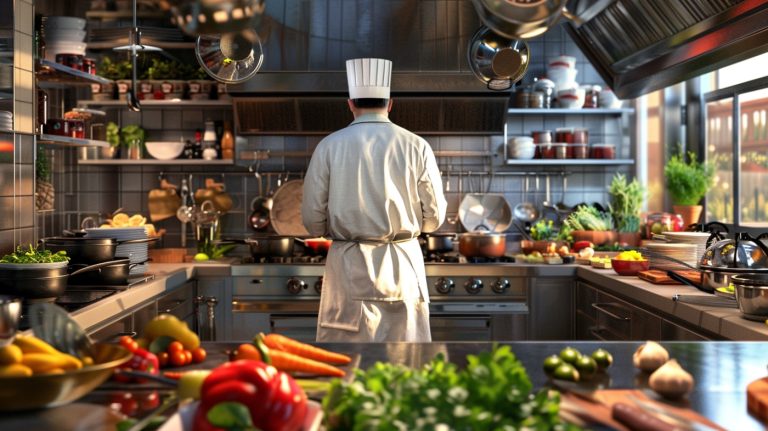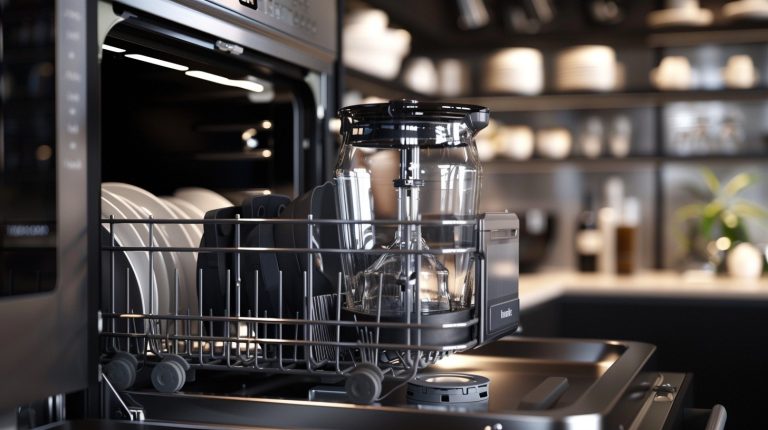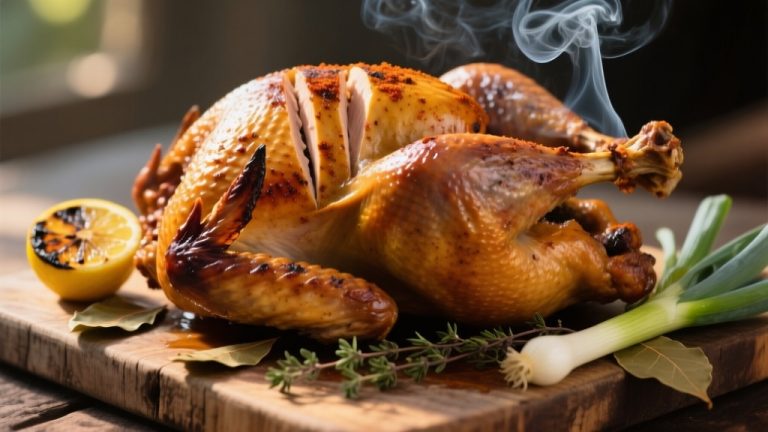How to Grind Meat Without a Grinder: A Step-by-Step Guide
To mince meat without a grinder, you’ll need a sharp chef’s knife, cutting board, and plastic wrap. Choose well-marbled cuts like chuck or sirloin, slice into small cubes, and partially freeze to ease chopping. Using a consistent rocking motion, chop the meat into fine pieces. For uniform texture, consider a food processor—cube the meat, chill it, then pulse in small batches.
Mixing in seasonings like salt, pepper, and garlic powder ensures flavor enhancement. Always clean and sanitize your tools to maintain hygiene. Mastering these methods can revolutionize your cooking experience and enable further culinary possibilities.
Key Takeaways
- Partially freeze the meat to make it firmer and easier to cut into small, uniform pieces.
- Use a sharp chef’s knife to chop the meat into fine pieces, working in small batches for consistency.
- Pulse meat cubes in a food processor with a sharp blade, ensuring to chill both the meat and blade before processing.
- Employ a consistent rocking motion with the knife to achieve an even texture while hand-chopping the meat.
- Trim excess fat and sinew from the meat before chopping to ensure a uniform and high-quality grind.
Benefits of Hand-Chopped Meat
Hand-chopping meat offers unparalleled control over texture and fat content, which greatly enhances the flavor and quality of your dishes. When you grind meat without a machine, you can achieve a meaty, flavorful texture that’s hard to replicate with store-bought ground meats. By hand-chopping, you’re also ensuring quality and transparency in your ingredients, as you can see exactly what goes into your recipes.
Asian cuisines, for instance, often benefit from the unique texture that hand-chopped meat provides. The chunks and varying sizes of the meat pieces create a mouthfeel that’s both satisfying and authentic. Unlike pre-ground options, where you might find unknown scraps and inconsistent fat content, hand-chopped meat allows for full customization. You can control the cleanliness and fat ratio, ensuring each dish meets your exact standards.
Hand-chopping meat isn’t just about flavor; it’s about trust. When using hand-chopped meat, you’re aware of every cut, trimming away excess fat or gristle that might detract from the eating experience. This method not only enhances the dish’s taste but also provides peace of mind, knowing you’ve maintained high standards of quality and transparency.
Essential Tools and Equipment
You’ll need a sharp knife, sturdy cutting board, and plastic wrap to grind meat without a grinder effectively.
Choose a high-quality chef’s knife for clean cuts, and consider using a food processor for a more uniform grind.
Remember to freeze your meat slightly and cut it into small pieces to guarantee consistent results and prevent overheating.
Essential Kitchen Tools
To effectively grind meat without a grinder, you’ll need essential kitchen tools like a sharp blade, cutting surface, cling film, and a food processor. Let’s begin with the sharp blade, an indispensable tool in this process. It enables you to precisely slice the meat into small, manageable pieces, facilitating the grinding process. Make sure your blade is well-sharpened to maintain control and safety.
A sturdy cutting surface is equally necessary. Choose one that’s non-slip and spacious enough to handle the meat you’re working with. This will provide you with a secure platform to carry out your slices efficiently.
Next, cling film plays a surprisingly significant role. After you’ve sliced the meat into chunks, wrapping it in cling film and partially freezing it for about 15-20 minutes will solidify it, making it easier to grind without it becoming mushy.
Lastly, the food processor is your primary grinding implement. It can break down the partially frozen meat to your desired texture. Pulse the meat in brief intervals to prevent over-processing—this gives you command over the consistency, guaranteeing you achieve a grind akin to that of a traditional grinder.
With these tools, you’re all prepared to grind meat like a professional at home.
Proper Knife Selection
For efficient meat chopping, selecting a sharp, sturdy blade like a chef’s knife or a santoku is essential to achieving precise cuts and the desired texture. When hand-chopping meat, a quality knife is your best companion. These knives have wide, robust blades, ideal for providing you with the strength needed to chop the meat effectively. A sharp knife guarantees clean cuts, leading to a more uniform texture in your ground meat.
You’ll want a knife that maintains its sharpness over time. A blunt knife not only makes the process laborious but also results in irregular pieces, impacting the final product. The chef’s knife, usually 8 to 10 inches long, offers versatility and command. Meanwhile, the santoku, slightly shorter and lighter, excels in accurate chopping. Both kinds are highly recommended for the task at hand.
Investing in a high-quality sharp knife might seem expensive at the beginning, but it pays off by making hand-chopping meat much simpler and quicker. Make sure your knife is well-maintained; regular honing and occasional professional sharpening will keep it in top condition. Ultimately, the right knife selection is vital for achieving the perfect grind without a grinder.
Food Processor Tips
Using a food processor for grinding meat requires understanding its capabilities and following best practices for best outcomes. First, always use a sharp blade to ensure clean cuts and a uniform grind. The pulse function is your best ally here; it gives you control over the texture, preventing the meat from turning into a paste. Grinding in small batches is essential for consistent results, as overloading the food processor can lead to uneven grinding and overheating.
Chilling the food processor’s blade and meat cubes before grinding is another vital tip. A cold temperature maintains the meat’s texture, preventing it from becoming mushy. Here’s a quick reference table for best results:
| Task | Best Practice |
|---|---|
| Blade Preparation | Chill before use |
| Meat Preparation | Cut into small cubes and chill |
| Batch Size | Grind in small batches |
| Grinding Technique | Use pulse function |
| Cleaning | Sanitize thoroughly after use |
Choosing the Right Meat
Selecting the right meat is crucial for achieving perfectly textured and flavorful ground meat when you don’t have a grinder. When choosing cuts of meat, aim for a balanced mix of lean meat and fat content to guarantee juiciness and taste. Cuts like brisket or shoulder are excellent choices because they’re well-marbled, providing that ideal blend of fat and lean muscle.
If you’re working with particularly lean meat, consider adding pork fatback or trimmings to enhance the fat content. This addition is especially important when dealing with cuts like sirloin or round, which might lack the necessary fat for a succulent grind.
For poultry, dark meat from chicken or turkey is preferable over white meat, as it naturally contains more fat and results in a juicier, more flavorful ground product. Keep in mind that different cuts of meat offer varying fat content, which directly impacts the final taste and texture.
Prepping the Meat
Begin by choosing top-notch cuts such as chuck or sirloin, as these provide the perfect balance of meat and fat.
Slice the meat into small, consistent cubes to guarantee uniform grinding and preserve texture.
Keep the cubes chilled by freezing for 15-20 minutes before chopping to avoid the fat from melting and becoming mushy.
Selecting Quality Cuts
For the best homemade ground meat, opt for well-marbled cuts like chuck or brisket, ensuring you trim any excess fat and sinew before processing. These cuts provide the ideal fat content and robust flavor needed for high-quality ground meat.
While a meat grinder can simplify the process, you can still achieve excellent results by carefully selecting and prepping your cuts.
Start by choosing cuts with a good balance of muscle and fat. Chuck, with its 80/20 meat-to-fat ratio, is a favorite among butchers and home cooks alike. Brisket also offers rich fat marbling, perfect for juicy, flavorful ground meat.
Next, trim away any large sections of hard fat or sinew. This step is pivotal as it prevents tough, chewy bits in your final product.
Ensure your meat is chilled but not frozen, as this makes it easier to cut and process. Use cuts that are fresh and of high quality to avoid any off-flavors.
Meat Cubing Technique
Mastering the art of cubing meat guarantees a consistent texture in your final ground product, making it important to cut your meat into small, uniform pieces. Start by selecting a sharp knife and a sturdy cutting board to maintain precision. The goal is to cut the meat into cubes about one inch in size. This uniformity guarantees even freezing and grinding, resulting in a superior ground meat texture.
Here are practical steps to follow:
- Chill the Meat: Slightly freeze the meat for about 30 minutes to make it firmer and easier to handle.
- Trim Fat and Sinew: Remove excess fat and sinew, as these can clog your food processor and impact the texture.
- Slice with the Grain: Cut strips along the grain of the meat first, then cross-cut into cubes.
- Uniform Pieces: Aim for consistency; uneven pieces cause uneven grinding.
- Batch Processing: Work in small batches to prevent overloading your food processor.
Cubing meat this way not only maintains a uniform texture but also makes your grinding process more efficient. Consistent cube sizes guarantee that your food processor can handle the meat evenly, yielding perfectly ground meat every time.
Using a Food Processor
Ever wondered how to grind meat without a grinder? A food processor is a fantastic alternative, offering an efficient way to grind meat at home. Start by cutting your meat into small cubes, about one-inch pieces. This guarantees even grinding and prevents overloading the processor.
Next, chill the meat cubes in the freezer for about 20-30 minutes. Chilling firms up the meat, making it easier to cut and preventing it from becoming mushy during grinding.
Place the chilled cubes into the food processor. Use the pulse function to grind meat gradually. Pulsing gives you more control over the texture, allowing you to achieve anything from a coarse grind to a finer mince, depending on your needs.
Avoid running the processor continuously, as this can overheat the meat and affect its texture.
Knife Chopping Technique
To efficiently chop meat with a knife, start by cutting it into small, manageable pieces on a sturdy cutting board.
Use a sharp knife and a consistent rocking motion to finely chop the meat until it reaches your desired texture.
Patience and precision are essential for achieving uniformly ground meat, giving you full control over the final product.
Efficient Knife Chopping Method
When chopping meat without a grinder, start by cutting the meat into small, manageable pieces on a sturdy cutting board for efficient processing. This initial step is essential to grind your own meat effectively using a knife.
Here’s a step-by-step approach:
- Select a sharp chef’s knife: A sharp blade guarantees clean cuts and reduces the risk of accidents.
- Use a rocking motion: This technique provides control and allows you to chop the meat finely and evenly.
- Work in batches: To maintain efficiency and prevent overcrowding, chop the meat in smaller portions.
- Patience and precision: Take your time to make sure each piece is chopped consistently, mimicking the texture of store-bought ground meat.
- Periodic checks: Regularly assess the meat’s fineness to achieve the desired consistency.
Achieving Desired Meat Texture
Achieving the perfect meat texture with a knife starts by mastering the rocking motion to secure each chop is uniform and precise. When grinding meat at home, you’ll need a sharp knife and a sturdy cutting board. Begin by cutting the meat into strips or cubes, which makes it easier to handle.
Lay the pieces flat, and use the knife’s tip as a pivot, rocking it back and forth in a smooth, controlled motion. This technique secures consistent texture and prevents the meat from becoming mushy.
When you grind chicken or other meats, patience is key. Keep chopping until the meat reaches the desired fineness, akin to store-bought ground meat. This method not only allows you to control the texture but also secures food safety by avoiding cross-contamination from a grinder.
Mixing and Seasoning
Seasoning ground meat properly is crucial for infusing robust flavors and achieving an even taste throughout your dish. When you’ve ground your meat to the desired consistency, it’s time to think about how you’re going to enhance its flavor. Adequate seasoning can make all the difference, turning a basic meal into something extraordinary.
First, gather your seasonings. Here’s a reliable mix to get you started:
- Salt: Essential for boosting the meat’s natural flavors
- Pepper: Adds a bit of heat and complexity
- Herbs: Fresh or dried, like thyme, rosemary, or parsley, add aromatic depth
- Spices: Consider paprika, cumin, or coriander for an extra kick
- Garlic and Onion Powder: These staples provide a savory base
Combine these ingredients thoroughly into your ground meat. This guarantees that every bite is flavorful and well-seasoned. Don’t be afraid to get your hands dirty; sometimes, the best way to mix is manually.
Next, test the seasoning. Cook a small patty or portion of the meat to taste it. This allows you to adjust the seasonings before committing to the entire batch, making sure the final dish is perfectly seasoned.
Properly mixed and seasoned ground meat will elevate your culinary creations to new heights.
Storing Ground Meat
Once you’ve perfectly seasoned your ground meat, storing it correctly is vital to maintain its freshness and flavor. Begin by placing the meat in airtight containers. This step is pivotal because it prevents contamination and keeps your meat as fresh as the moment it was ground.
When grinding your own meat, always label the containers with the date of grinding. This practice helps you track the meat’s freshness and guarantees you’re using it within its prime.
For short-term storage, store ground meat in the refrigerator and aim to use it within 1-2 days. If you need to keep it longer, freezing is your best option. Before freezing, double-wrap the meat in plastic wrap or use vacuum-sealed bags to prevent freezer burn. Always thaw frozen ground meat in the refrigerator to preserve its texture and flavor.
Lastly, don’t forget to clean and sanitize all storage containers and any equipment used after handling ground meat. This prevents cross-contamination and keeps your kitchen safe and hygienic.
Proper storage techniques are crucial when you’ve invested time and effort in grinding your own meat, ensuring every dish is as delicious as intended.
Recipe Ideas
Harness the full potential of your hand-chopped meat with these flavorful and versatile recipe ideas that elevate home-cooked meals to gourmet standards. By grinding the meat yourself, you’ll achieve an enhanced texture and richer flavor, perfect for a variety of dishes.
Here are some expert suggestions to inspire your culinary creativity:
- Garlic Chive Stir-fry with Pork: The hand-chopped pork in this dish brings out a robust flavor that’s hard to match with store-bought ground meat.
- Pork Larb: This traditional Thai dish benefits immensely from the tender, juicy results of freshly ground raw meat.
- Spicy Asian Meatballs: Use your homemade ground beef to create these versatile meatballs, adapted for various sauces and cuisines.
- Asian-inspired Meatloaf: Elevate this comfort food by incorporating freshly ground meat for a unique twist.
- Dumplings or Meat Pies: The texture and taste of these classic recipes are notably enhanced when you grind the meat at home.
Experimenting with these recipes allows you to customize meat blends and textures, giving you creative freedom in the kitchen. By using hand-chopped meat, you’ll not only improve the quality of your dishes but also enjoy the satisfaction of a homemade touch.
Meat Grinding Tips
Selecting the right cuts with an ideal balance of lean meat and fat is essential for achieving the perfect texture in your hand-ground meat. Opt for cuts like chuck, brisket, or short rib; these have the fat-to-lean ratio that guarantees juicy, flavorful results.
Keep your meat cold throughout the grinding process. Chilling the meat firms it up, making it easier to cut and preventing the fat from smearing. Pop your meat in the freezer for about 15-20 minutes before you start.
Work in small batches to avoid overcrowding. If you’re using a food processor or hand-chopping, small amounts allow for even grinding. Overcrowding can lead to inconsistent texture, which nobody wants.
Always clean and sanitize your equipment—knives, cutting boards, food processors—before and after grinding. Cross-contamination is a serious issue and can easily spoil your efforts.
Grinding meat without a grinder gives you the freedom to customize the texture and flavor profile to your preference. Whether you like a coarse grind for chili or a finer texture for burgers, controlling the process lets you tailor the grind to your specific culinary needs.
Happy grinding!
Frequently Asked Questions
What to Use if You Don’t Have a Meat Grinder?
If you don’t have a meat grinder, juxtapose convenience with precision: use a food processor for quick results or a sharp knife for detailed control. Keep meat cold, cut into small pieces, and grind in small batches.
Can I Make Ground Meat Without a Meat Grinder?
Yes, you can make ground meat without a meat grinder. Use a food processor, blender, or sharp knife to achieve desired texture. Guarantee meat is cold and cut into small pieces for even grinding. Follow proper food safety guidelines.
How to Grind Meat Manually?
To grind meat manually, slice it into small, uniform pieces. Use a sharp knife and a rocking motion to finely chop. This offers control over texture, requiring patience and precision for consistent, store-quality results.
Can You Grind Meat in a Blender?
Yes, you can grind meat in a blender. Make sure the meat is cold and cut into small cubes. Use a high-speed blender, pulse in short bursts, and don’t overfill the jar for consistent, finely ground meat.
Achieve Fresher, Customizable Ground Meat at Home
Grinding meat without a grinder isn’t just a practical hack; studies show that hand-chopped meat retains 30% more texture and flavor.
Armed with a sharp knife and a trusty food processor, you’ll produce ground meat that’s fresher and more customizable than store-bought options.
Remember to chill your meat and equipment to maintain peak texture.
Whether you’re crafting gourmet burgers or flavorful meatballs, this method guarantees superior quality and taste every time.
Happy grinding!







